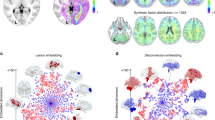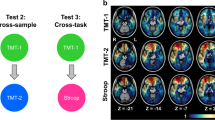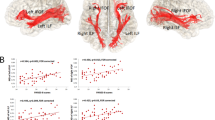Abstract
Structural brain imaging is increasingly introduced as evidence in criminal trials. A key imaging abnormality identified in criminal populations is alteration to the right uncinate fasciculus but it remains unclear whether these changes play a causal role in criminal behavior. Lesion studies of acquired criminality offer the opportunity to assess the causal role of focal disruption of specific white matter connections in criminal behavior. We studied lesion locations of focal brain damage associated with new onset criminal behavior compared to lesions associated with 21 diverse neuropsychiatric symptoms. First, we analyzed the intersection of lesion locations with an atlas-based right uncinate fasciculus. Second, we assessed the intersection of lesion locations with all white matter tracts from this atlas. Third, we performed a connectome-based analysis of all possible white matter connections with each lesion ___location, without a priori assumptions regarding specific tracts. We repeated all analyses limited to subjects who committed violent crimes. Lesions associated with criminality intersected the right uncinate more than lesions associated with other neuropsychiatric symptoms (p = 4.78 × 10−8). Compared to other tracts, the right uncinate fasciculus was the tract most strongly associated with lesion-induced criminality followed by the forceps minor. An unbiased connectome-based analysis confirmed these findings. Among subjects who committed violent crimes the right uncinate was the key tract identified. Lesions associated with criminality intersect the right uncinate fasciculus more than other lesions and more than other white matter tracts. Damage to the right uncinate may play a causal role in criminal behavior, especially violent crime.
This is a preview of subscription content, access via your institution
Access options
Subscribe to this journal
Receive 12 print issues and online access
269,00 € per year
only 22,42 € per issue
Buy this article
- Purchase on SpringerLink
- Instant access to full article PDF
Prices may be subject to local taxes which are calculated during checkout



Similar content being viewed by others
Data availability
The networks from the analyses (Fig. 3) are publicly available at: https://identifiers.org/neurovault.collection:15236. The code to prepare structural connectivity maps is available at: https://storage.googleapis.com/bcblabweb/index.html and the structural connectivity data is available at: https://www.humanconnectome.org/study/hcp-young-adult/document/1200-subjects-data-release. Statistical analyses were performed in MatLab (version 2019b), FSL (version 6.0.4) and SPSS (version 28.0.0.0).
References
Guza M. Bowers’ brain functions scrutinized testimony presented about abnormalities. Pittsburgh, PA: Pittsburgh Post – Gazette; 2023.
Guza M. Prosecutor pokes holes in defense strategy. Pittsburgh, PA: Pittsburgh Post - Gazette; 2023.
Zheng D, Considine CM, Weinstock R, Darby WC, Darby RR. Forensic neurology: practice considerations and training opportunities. Neurology. 2024;103:e209560.
Philipps D. Profound damage found in maine gunman’s brain, possibly from blasts. Late Edn. New York, N.Y.: New York Times; 2024.
Darby RR, Considine C, Weinstock R, Darby WC. Forensic neurology: a distinct subspecialty at the intersection of neurology, neuroscience and law. Nat Rev Neurol. 2024;20:183–93.
Denno DW. How experts have dominated the neuroscience narrative in criminal cases for twelve decades: a warning for the future. William Mary Law Rev. 2022;63:1215.
Greely HT, Farahany NA. Neuroscience and the criminal justice system. Annu Rev criminol. 2019;2:451–71.
Darby RR. Network localization of antisocial behavior in neurological patients: evidence and implications. Handb Clin Neurol. 2023;197:45–54.
Press conference: report to the governor, medical aspects Charles J. Whitman catastrophe: Austin; Archives and Information Services Division, Texas State Library and Archives Commission: 1966.
Tonkonogy JM. Violence and temporal lobe lesion: head CT and MRI data. J Neuropsychiatry Clin Neurosci. 1991;3:189–96.
Anderson SW, Bechara A, Damasio H, Tranel D, Damasio AR. Impairment of social and moral behavior related to early damage in human prefrontal cortex. Nat Neurosci. 1999;2:1032–7.
Wortzel HS, Kraus MF, Filley CM, Anderson CA, Arciniegas DB. Diffusion tensor imaging in mild traumatic brain injury litigation. J Am Acad Psychiatry Law. 2011;39:511–23.
van Velkinburgh JC, Herbst MD, Casper SM. Diffusion tensor imaging in the courtroom: Distinction between scientific specificity and legally admissible evidence. World J Clin Cases. 2023;11:4477–97.
Craig MC, Catani M, Deeley Q, Latham R, Daly E, Kanaan R, et al. Altered connections on the road to psychopathy. Mol Psychiatry. 2009;14:946–53.
Motzkin JC, Newman JP, Kiehl KA, Koenigs M. Reduced prefrontal connectivity in psychopathy. J Neurosci. 2011;31:17348–57.
Hoppenbrouwers SS, Nazeri A, de Jesus DR, Stirpe T, Felsky D, Schutter DJLG, et al. White Matter Deficits in Psychopathic Offenders and Correlation with Factor Structure. PLoS ONE. 2013;8:e72375.
Wolf RC, Pujara MS, Motzkin JC, Newman JP, Kiehl KA, Decety J, et al. Interpersonal traits of psychopathy linked to reduced integrity of the uncinate fasciculus. Hum Brain Mapp. 2015;36:4202–9.
Beyer F, Munte TF, Wiechert J, Heldmann M, Kramer UM. Trait aggressiveness is not related to structural connectivity between orbitofrontal cortex and amygdala. PLoS ONE. 2014;9:e101105.
Karlsgodt KH, Bato AA, Blair MA, DeRosse P, Szeszko PR, Malhotra AK. White matter microstructure in the executive network associated with aggression in healthy adolescents and young adults. Soc Cogn Affect Neurosci. 2015;10:1251–6.
Lindner P, Savic I, Sitnikov R, Budhiraja M, Liu Y, Jokinen J, et al. Conduct disorder in females is associated with reduced corpus callosum structural integrity independent of comorbid disorders and exposure to maltreatment. Transl Psychiatry. 2016;6:e714.
Churchland PS. Conscience: the origins of moral intuition. 1st edn. New York: W.W. Norton & Company; 2019. p. 226.
Churchland PS. Braintrust: what neuroscience tells us about morality. Princeton, NJ: Princeton University Press; 2011.
Glenn AL, Raine A. Neurocriminology: implications for the punishment, prediction and prevention of criminal behaviour. Nat Rev Neurosci. 2014;15:54–63.
Siddiqi SH, Kording KP, Parvizi J, Fox MD. Causal mapping of human brain function. Nat Rev Neurosci. 2022;23:361–75.
Darby RR, Horn A, Cushman F, Fox MD. Lesion network localization of criminal behavior. Proc Natl Acad Sci USA. 2018;115:601–6.
Taylor JJ, Lin C, Talmasov D, Ferguson MA, Schaper F, Jiang J, et al. A transdiagnostic network for psychiatric illness derived from atrophy and lesions. Nat Hum Behav. 2023;7:420–9.
Siddiqi SH, Schaper F, Horn A, Hsu J, Padmanabhan JL, Brodtmann A, et al. Brain stimulation and brain lesions converge on common causal circuits in neuropsychiatric disease. Nat Hum Behav. 2021;5:1707–16.
Meyers CA, Berman SA, Scheibel RS, Hayman A. Case report: acquired antisocial personality disorder associated with unilateral left orbital frontal lobe damage. J Psychiatry Neurosci. 1992;17:121–5.
Eslinger PJ, Damasio AR. Severe disturbance of higher cognition after bilateral frontal lobe ablation: patient EVR. Neurology. 1985;35:1731–41.
Blair RJ, Cipolotti L. Impaired social response reversal. A case of ‘acquired sociopathy’. Brain. 2000;123:1122–41.
Tranel D, Bechara A, Denburg NL. Asymmetric functional roles of right and left ventromedial prefrontal cortices in social conduct, decision-making, and emotional processing. Cortex. 2002;38:589–612.
Nakaji P, Meltzer HS, Singel SA, Alksne JF. Improvement of aggressive and antisocial behavior after resection of temporal lobe tumors. Pediatrics. 2003;112:e430.
Mitchell DGV, Fine C, Richell RA, Newman C, Lumsden J, Blair KS, et al. Instrumental learning and relearning in individuals with psychopathy and in patients with lesions involving the amygdala or orbitofrontal cortex. Neuropsychology. 2006;20:280–9.
Orellana G, Alvarado L, Munoz-Neira C, Avila R, Mendez MF, Slachevsky A. Psychosis-related matricide associated with a lesion of the ventromedial prefrontal cortex. J Am Acad Psychiatry Law. 2013;41:401–6.
Sener MT, Ozcan H, Sahingoz S, Ogul H. Criminal responsibility of the frontal lobe syndrome. Eurasian J Med. 2015;47:218–22.
Subasi H, Isman-Haznedaroglu D, Eroglu S, Erdogan Y, Eker MC, Gonul AS. Personality change after ‘flow diverter implantation’ for intracranial aneurysm in a patient with stroke: a case report. Brain Inj. 2023;37:1231–4.
Balcioglu YH, Dogan M, Inci I, Solmaz M. Sexual behavioral disinhibition associated with nucleus lentiformis lesion: a forensic neuroscience perspective through a case. J Forensic Sci. 2020;65:1779–83.
Boes AD, Prasad S, Liu H, Liu Q, Pascual-Leone A, Caviness VS Jr., et al. Network localization of neurological symptoms from focal brain lesions. Brain. 2015;138:3061–75.
Kletenik I, Ferguson MA, Bateman JR, Cohen AL, Lin C, Tetreault A, et al. Network localization of unconscious visual perception in blindsight. Ann Neurol. 2022;91:217–24.
Foulon C, Cerliani L, Kinkingnehun S, Levy R, Rosso C, Urbanski M, et al. Advanced lesion symptom mapping analyses and implementation as BCBtoolkit. Gigascience. 2018;7:1–17.
Yeh FC. Population-based tract-to-region connectome of the human brain and its hierarchical topology. Nat Commun. 2022;13:4933.
Thiebaut de Schotten M, Tomaiuolo F, Aiello M, Merola S, Silvetti M, Lecce F, et al. Damage to white matter pathways in subacute and chronic spatial neglect: a group study and 2 single-case studies with complete virtual “in vivo” tractography dissection. Cereb Cortex. 2014;24:691–706.
Filley CM, Kletenik I, Churchland PS. Morality and the brain: the right hemisphere and doing right. Cogn Behav Neurol. 2020;33:304–7.
Vu AT, Auerbach E, Lenglet C, Moeller S, Sotiropoulos SN, Jbabdi S, et al. High resolution whole brain diffusion imaging at 7T for the Human Connectome Project. Neuroimage. 2015;122:318–31.
Kletenik I, Cohen AL, Glanz BI, Ferguson MA, Tauhid S, Li J, et al. Multiple sclerosis lesions that impair memory map to a connected memory circuit. J Neurol. 2023;270:5211–22.
Jenkinson M, Beckmann CF, Behrens TE, Woolrich MW, Smith SM. FSL. Neuroimage. 2012;62:782–90.
Rise HH, Brune S, Chien C, Berge T, Bos SD, Andorra M, et al. Brain disconnectome mapping derived from white matter lesions and serum neurofilament light levels in multiple sclerosis: a longitudinal multicenter study. Neuroimage Clin. 2022;35:103099.
Sundram F, Deeley Q, Sarkar S, Daly E, Latham R, Craig M, et al. White matter microstructural abnormalities in the frontal lobe of adults with antisocial personality disorder. Cortex. 2012;48:216–29.
Pandya DN, Schmahmann JD. Uncinate fasciculus. New York: Oxford University Press; 2006.
Hau J, Sarubbo S, Houde JC, Corsini F, Girard G, Deledalle C, et al. Revisiting the human uncinate fasciculus, its subcomponents and asymmetries with stem-based tractography and microdissection validation. Brain Struct Funct. 2017;222:1645–62.
Blair RJ. The amygdala and ventromedial prefrontal cortex in morality and psychopathy. Trends Cogn Sci. 2007;11:387–92.
Von Der Heide RJ, Skipper LM, Klobusicky E, Olson IR. Dissecting the uncinate fasciculus: disorders, controversies and a hypothesis. Brain. 2013;136:1692–707.
Schmahmann JD, Pandya DN. Fiber pathways of the brain. Oxford: Oxford University Press; 2009.
Olson IR, Von Der Heide RJ, Alm KH, Vyas G. Development of the uncinate fasciculus: implications for theory and developmental disorders. Dev Cogn Neurosci. 2015;14:50–61.
Sarkar S, Craig MC, Catani M, Dell’acqua F, Fahy T, Deeley Q, et al. Frontotemporal white-matter microstructural abnormalities in adolescents with conduct disorder: a diffusion tensor imaging study. Psychol Med. 2013;43:401–11.
Passamonti L, Fairchild G, Fornito A, Goodyer IM, Nimmo-Smith I, Hagan CC, et al. Abnormal anatomical connectivity between the amygdala and orbitofrontal cortex in conduct disorder. PLoS ONE. 2012;7:e48789.
Oishi K, Faria AV, Hsu J, Tippett D, Mori S, Hillis AE. Critical role of the right uncinate fasciculus in emotional empathy. Ann Neurol. 2015;77:68–74.
Bateman JR, Ferguson MA, Anderson CA, Arciniegas DB, Gilboa A, Berman BD, et al. Network localization of spontaneous confabulation. J Neuropsychiatry Clin Neurosci. 2024;36:45–52.
Ballester J, Goldstein T, Goldstein B, Obreja M, Axelson D, Monk K, et al. Is bipolar disorder specifically associated with aggression? Bipolar Disord. 2012;14:283–90.
Darby RR, Laganiere S, Pascual-Leone A, Prasad S, Fox MD. Finding the imposter: brain connectivity of lesions causing delusional misidentifications. Brain. 2017;140:497–507.
Lee K, Shinbo M, Kanai H, Nagumo Y. Reduplicative paramnesia after a right frontal lesion. Cogn Behav Neurol. 2011;24:35–39.
Hirstein W, Ramachandran VS. Capgras syndrome: a novel probe for understanding the neural representation of the identity and familiarity of persons. Proc Biol Sci. 1997;264:437–44.
Keane J, Calder AJ, Hodges JR, Young AW. Face and emotion processing in frontal variant frontotemporal dementia. Neuropsychologia. 2002;40:655–65.
Sethi A, Gregory S, Dell’Acqua F, Periche Thomas E, Simmons A, Murphy DG, et al. Emotional detachment in psychopathy: Involvement of dorsal default-mode connections. Cortex. 2015;62:11–19.
Hornberger M, Geng J, Hodges JR. Convergent grey and white matter evidence of orbitofrontal cortex changes related to disinhibition in behavioural variant frontotemporal dementia. Brain. 2011;134:2502–12.
Wang Y, Metoki A, Xia Y, Zang Y, He Y, Olson IR. A large-scale structural and functional connectome of social mentalizing. Neuroimage. 2021;236:118115.
Bubb EJ, Metzler-Baddeley C, Aggleton JP. The cingulum bundle: anatomy, function, and dysfunction. Neurosci Biobehav Rev. 2018;92:104–27.
Mendez MF. The neurobiology of moral behavior: review and neuropsychiatric implications. CNS Spectr. 2009;14:608–20.
Wang Y, Olson IR. The original social network: white matter and social cognition. Trends Cogn Sci. 2018;22:504–16.
Mendez MF. The implications of moral neuroscience for brain disease: review and update. Cogn Behav Neurol. 2023;36:133–44.
Wang Y, Metoki A, Alm KH, Olson IR. White matter pathways and social cognition. Neurosci Biobehav Rev. 2018;90:350–70.
Filley CM. Social cognition and white matter: connectivity and cooperation. Cogn Behav Neurol. 2020;33:67–75.
Churchland PS. Moral decision-making and the brain. Oxford: Oxford University Press; 2004.
de Leeuw FE, de Groot JC, Achten E, Oudkerk M, Ramos LM, Heijboer R, et al. Prevalence of cerebral white matter lesions in elderly people: a population based magnetic resonance imaging study. the rotterdam scan study. J Neurol Neurosurg Psychiatry. 2001;70:9–14.
Pardini M, Krueger F, Hodgkinson C, Raymont V, Ferrier C, Goldman D, et al. Prefrontal cortex lesions and MAO-A modulate aggression in penetrating traumatic brain injury. Neurology. 2011;76:1038–45.
Mednick SA, Gabrielli WF, Hutchings B. Genetic influences in criminal convictions: evidence from an adoption cohort. Science. 1984;224:891–4.
Jones SE, Miller JD, Lynam DR. Personality, antisocial behavior, and aggression: a meta-analytic review. J Crim Justice. 2011;39:329–37.
Galler JR, Bryce C, Waber DP, Zichlin ML, Fitzmaurice GM, Eaglesfield D. Socioeconomic outcomes in adults malnourished in the first year of life: a 40-year study. Pediatrics. 2012;130:e1–7.
Kletenik I. Arise and judge the earth. Ann Intern Med. 2012;157:752.
Focquaert F. Neurobiology and crime: a neuro-ethical perspective. J Crim Justice. 2019;65:101533.
Cohen AL, Soussand L, Corrow SL, Martinaud O, Barton JJS, Fox MD. Looking beyond the face area: lesion network mapping of prosopagnosia. Brain. 2019;142:3975–90.
Padmanabhan JL, Cooke D, Joutsa J, Siddiqi SH, Ferguson M, Darby RR, et al. A human depression circuit derived from focal brain lesions. Biol Psychiatry. 2019;86:749–58.
Schaper F, Nordberg J, Cohen AL, Lin C, Hsu J, Horn A, et al. Mapping lesion-related epilepsy to a human brain network. JAMA Neurol. 2023;80:891–902.
Kiehl KA, Anderson NE, Aharoni E, Maurer JM, Harenski KA, Rao V, et al. Age of gray matters: Neuroprediction of recidivism. Neuroimage Clin. 2018;19:813–23.
Harding DJ, Morenoff JD, Nguyen AP, Bushway SD, Binswanger IA. A natural experiment study of the effects of imprisonment on violence in the community. Nat Hum Behav. 2019;3:671–7.
Sampaio-Baptista C, Johansen-Berg H. White matter plasticity in the adult brain. Neuron. 2017;96:1239–51.
O’Brien S, Sethi A, Blair J, Viding E, Beyh A, Mehta MA, et al. Rapid white matter changes in children with conduct problems during a parenting intervention. Transl Psychiatry. 2023;13:339.
Kletenik I, Gaudet K, Prasad S, Cohen AL, Fox MD. Network localization of awareness in visual and motor anosognosia. Ann Neurol. 2023;94:434–41.
Cohen AL, Mulder BPF, Prohl AK, Soussand L, Davis P, Kroeck MR, et al. Tuber locations associated with infantile spasms map to a common brain network. Ann Neurol. 2021;89:726–39.
Joutsa J, Moussawi K, Siddiqi SH, Abdolahi A, Drew W, Cohen AL, et al. Brain lesions disrupting addiction map to a common human brain circuit. Nat Med. 2022;28:1249–55.
Acknowledgements
Data were provided, in part, by the Human Connectome Project, WU-Minn Consortium (Principal Investigators: David Van Essen and Kamil Ugurbil; 1U54MH091657) funded by the 16 NIH Institutes and Centers that support the NIH Blueprint for Neuroscience Research; and by the McDonnell Center for Systems Neuroscience at Washington University.
Funding
IK receives funding from NIH NINDS L30 NS134024. AC was funded by NIH/NIMH K23MH120510, the Child Neurology Foundation, and the Simons Foundation Autism Research Initiative Bridge to Independence Fellowship. MDF was supported by the Nancy Lurie Marks Foundation, the Mather’s Foundation, the Ellison / Baszucki Foundation, the Kaye Family Research Endowment and National Institutes of Health grants R21 MH126271, R56 AG069086, R01 MH113929, R01 MH115949, and R01 AG060987. RRD was supported by National Institutes of Health, National Institute on Aging grant K23 AG070320-01A1.
Author information
Authors and Affiliations
Contributions
IK, CMF, RRD and MDF conceived and designed the work; IK, RRD and MDF acquired the data; IK, ALC, WD, RRD and MDF analyzed and interpreted data; IK, CMF, PSC, RRD and MDF drafted the work; IK, CMF, ALC, PSC, RRD and MDF revised the manuscript critically for important intellectual content.
Corresponding author
Ethics declarations
Competing interests
MDF is a consultant for Magnus Medical and Soterix and holds intellectual property on using connectivity imaging to guide brain stimulation. RRD served as an expert witness in a criminal case mentioned in this article; all data described in reference to this case was gathered independently by IK from publicly available resources. The other authors report no competing interests.
Ethics approval
The study was approved by Mass General Brigham/Partners Institutional Review Board Protocol 2020P002987 in accordance with the ethical standards laid down in the 1964 Declaration of Helsinki and its later amendments. We analyzed previously published, publicly available images with informed patient consent per individual journal requirements.
Additional information
Publisher’s note Springer Nature remains neutral with regard to jurisdictional claims in published maps and institutional affiliations.
Supplementary information
Rights and permissions
Springer Nature or its licensor (e.g. a society or other partner) holds exclusive rights to this article under a publishing agreement with the author(s) or other rightsholder(s); author self-archiving of the accepted manuscript version of this article is solely governed by the terms of such publishing agreement and applicable law.
About this article
Cite this article
Kletenik, I., Filley, C.M., Cohen, A.L. et al. White matter disconnection in acquired criminality. Mol Psychiatry (2025). https://doi.org/10.1038/s41380-025-03076-z
Received:
Revised:
Accepted:
Published:
DOI: https://doi.org/10.1038/s41380-025-03076-z



